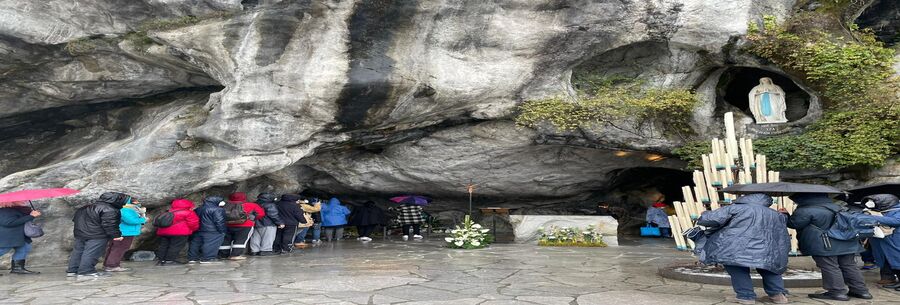A gesture of faith and connection
Touching the rock at the Massabielle grotto in Lourdes is an act charged with spirituality for pilgrims from all over the world. This simple gesture consists of brushing against the rock face where the Virgin Mary is said to have appeared to Bernadette Soubirous in 1858. For believers, this stone represents much more than just a natural feature. It bears witness to these apparitions and to the divine presence in this sacred place. Laying your hand on the rock allows you to feel a direct connection with this miraculous event, to soak up the spiritual power of the place and enter into communion with millions of faithful before them.
A thousand-year-old tradition of devotion
For over 160 years, touching the rock has been a tradition carried on by generations of pilgrims. This gesture of devotion is an integral part of the spiritual journey at Lourdes. By bending down to touch the rock, pilgrims are part of a long history of faith and belief in divine healing. Over time, the rock itself has been transformed, smoothed by the millions of hands that have touched it. This direct contact with the grotto constitutes an intimate moment of recollection, a silent prayer transmitted by a simple gesture.
A quest for healing and comfort
One of the most powerful aspects of the pilgrimage to Lourdes is the hope of healing, whether physical or spiritual. For many, touching the Massabielle rock symbolises a quest for comfort and renewal. The stone is seen as an anchor, a place to lay down one's sufferings, sorrows and hopes. Pilgrims, who often come in the hope of healing or easing their pain, approach this stone with a deep sense of respect and faith. Some report finding inner peace or the strength to continue their struggle after touching the rock.
A symbol of unity between believers
This gesture is also a symbol of unity, linking pilgrims together. Believers from the four corners of the world share the same experience, that of touching the sacred stone of the Massabielle grotto. This physical contact with the site of the apparitions unites people in their common faith, their desire for healing and their quest for meaning. The rock thus becomes a universal symbol of prayer, contemplation and hope, transcending languages, cultures and borders.
A unique spiritual experience
To conclude, touching the rock at Lourdes is a deeply personal experience, but one that is part of a collective dynamic. Everyone comes with their own intentions: some seek healing, others peace, and still others simply wish to feel the divine presence. This gesture of humility before the stone of Massabielle marks a moment of intense spiritual communion, where the touch becomes a silent and powerful prayer. The grotto, with its sacred rock, remains one of the most important places for those seeking to reconnect with their faith or to find a moment of peace and recollection.
Thus, touching the rock at the grotto of Massabielle is not a simple ritual, but an act of faith, unity, and a search for healing, where each person can find, in their own way, an echo to their prayers.




















